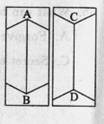题目内容
--Honey, this is a present for your birthday.
--Ah! A pare of shoes, well-known brand——Nike, I think it comfortable.
A.wears B.is worn C.is wearing D.has worn
A

--Mum, I don’t think I am qualified enough to do this.
--Honey, be confident! You should know it is ____ a man thinks of himself ___ really determines his fate.
| A.that; that | B.how; that | C.what; that | D.how; how |
Can trees talk? Yes, but not in words. Scientists have reason to believe that trees do communicate (交际) with each other. Not long ago, researchers learned some surprising things. First a willow tree attacked in the woods by caterpillars (毛虫) changed the chemistry of its leaves and made them taste so terrible that they got tired of the leaves and stopped eating them. Then even more astonishing, the tree sent out a special smell---a signal (信号) causing its neighbors to change the chemistry of their own leaves and make them less tasty.
Communication, of course, doesn’t need to be in words. We can talk to each other by smiling, raising our shoulders and moving our hands. We know that birds and animals use a whole vocabulary of songs, sounds, and movements. Bees dance their signals, flying in certain patterns that tell other bees where to find nectar (花蜜) for honey. So why shouldn’t trees have ways of sending message?
【小题1】It can be concluded from the passage that caterpillars do not feed on leaves that ______.
| A.are lying on the ground | B.have an unpleasant taste |
| C.bees don’t like | D.have an unfamiliar shape |
| A.growing more branches | B.communicating with birds and bees |
| C.changing its leaf chemistry | D.shaking caterpillars off |
| A.waving its branches | B.giving off a special smell |
| C.dropping its leaves | D.changing the colour of its trunk |
| A.making special movement | B.Telling one another |
| C.smelling one another | D.making unusual sound |
[1] Look at the center circles of Diagram A and Diagram B. Which of the centre circles looks larger? 
[2] Take a first look and you probably think that the centre circle in Diagram A is smaller than that in Diagram B. In fact, they are exactly the same size.
[3]Then look at the picture on the right. What do you see? A vase? Or two faces? Does the picture change quickly from one to the other again and again? Maybe or maybe not, but you can see them at the same time. 
[4]“What’s happening? Is something wrong with my eyes?” You may wonder at what you see. Don’t worry. Here is how it goes:
[5]When we look at things, our eyes send messages to our brains and then our brains interpret the information. However, sometimes our brains interpret the received information in a wrong way. It seems that our eyes are playing a joke on us. This often happens and we call it “Visual illusion(幻觉)”. 
[6] Movie makers often make use of illusions. They make the objects around actors much smaller or bigger than usual. This makes us believe that the actors are much larger or smaller than they usually are. The movies Jurassic Park and Honey J shrunk the kids just make use of illusions.
【小题1】In which column of a magazine can you read the above text?
| A.Culture. | B.Science. | C.Humour. | D.Education. |
| A.something is wrong with our eyes |
| B.the two circles are not of the same size |
| C.our brains interpret the information wrongly |
| D.pictures change quickly from one to the other |
A. The second one. B. The third one. C. The sixth one.. D. The fifth one
【小题4】What’s the right order according to the text?
a. We look at things with our eyes. b. Our brains interpret the messages.
c. Our brains tell us what we have seen. d. Our eyes send messages to our brains.
A. a-d-b-c B c-a-b-d C a-c-d-b D. b-e-a-d